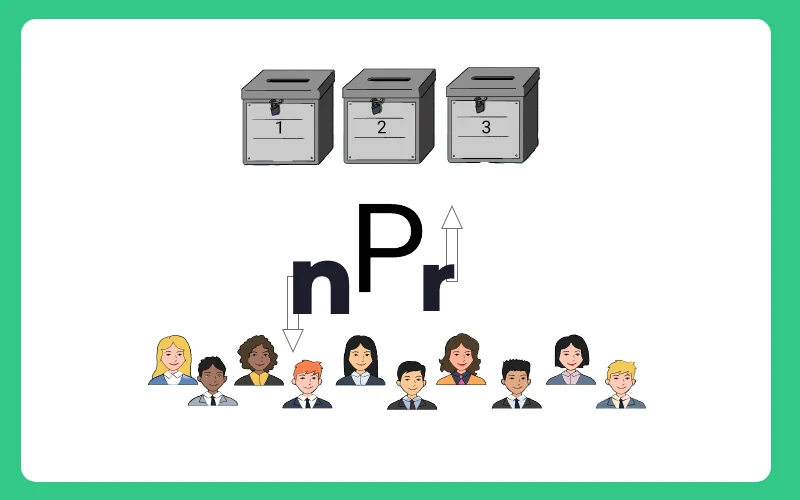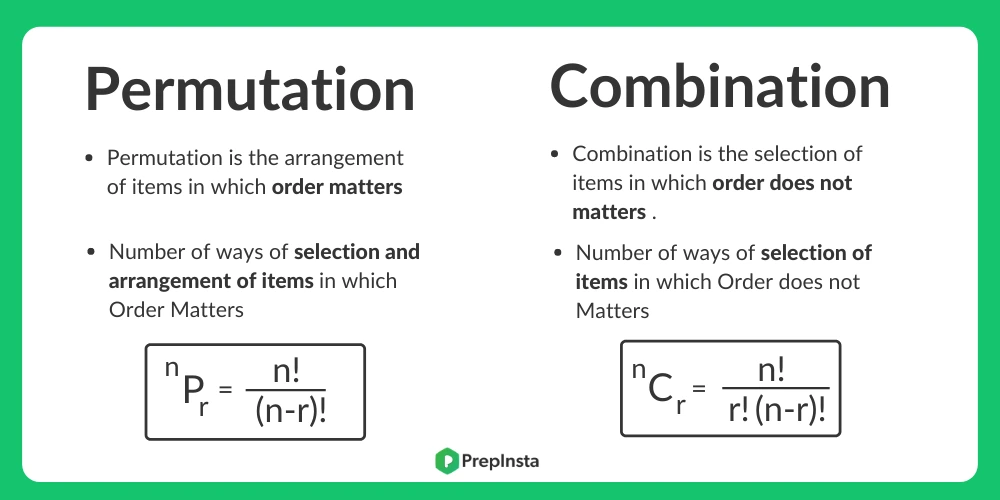Quants Menu
- HCF and LCM
- Number System
- Number Decimals & Fractions
- Surds and Indices
- Divisibility
- Ages
- LCM
- HCF
- Inverse
- Speed Time and Distance
- Work and Time
- Boats and Streams
- Pipes and Cisterns
- Averages
- Allegations and Mixtures
- Ratio and Proportions
- Simple & Compound Interest
- Simple Interest
- Compound Interest
- Percentages
- Profit & Loss
- Successive Discount 1
- Successive Discount 2
- AP GP HP
- Arithmetic Progressions
- Geometric Progressions
- Harmonic Progressions
- Probability
- Permutation & Combination
- Combination
- Circular Permutation
- Geometry
- Heights and Distances
- Perimeter Area and Volume
- Coordinate Geometry
- Venn Diagrams
- Set Theory
- Algebra
- Linear Equations
- Quadratic Equations
- Logarithms
- Clocks
- Calendars
- Clocks and Calendars
- Finding remainder of large powers
PREPINSTA PRIME
Permutation and Combination Formulas
Permutation and Combination Formulas
Permutation and Combination Formulas has been discussed on this page to help student remember all important formulas in last min before exam.
Permutation:
The different arrangements of a given number of things by taking some or all at a time, are called permutations. This is denoted by ^n P_r . Permutations are studied in almost every branch of mathematics, and in many other fields of science. In computer science, they are used for analyzing sorting algorithms.
Combination:
Each of the different groups or selections which can be formed by taking some or all of a number of objects is called a combination. This is denoted by ^n C_r

Permutation and Combination Formulas
- Number of all permutations of n things, taken r at a time, is given by
^n P_r = \frac{n!}{(n-r)!} - Number of all combinations of n things, taken r at a time, is given by
^n C_r = \frac{n!}{(r)! (n-r)!}
Points to remember
- Factorial of any negative quantity is not valid.
- If a particular thing can be done in m ways and another thing can be done in n ways, then
- Either one of the two can be done in m + n ways and
- Both of them can be done in m × n ways
- 0! = 1
- 1! = 1
- If from the total set of n objects and ‘p1’ are of one kind and ‘p2’ and ‘p3’ and so on …. till pr are others respectively then
^n P_r = \frac{n!}{p_1 ! × q_2 ! × ……. p_r !} - nPn = n!
- ncn = 1
- nc0 = 1
- ncr = nc(n-r)
- nc0+nc1+nc2+nc3+…ncn = 2n

Prime Course Trailer
Related Banners
Get PrepInsta Prime & get Access to all 200+ courses offered by PrepInsta in One Subscription
Permutation and Combination Formulas- Factorial
n ! = n(n-1)(n-2) …… 1 Eg. – 5! = 5(5-1)(5-2)(5-3)(5-4) = 5(4)(3)(2)(1)Standard Truths
- 0! = 1
- n! only exists of n >= 0 and doesn’t exist for n < 0
| n | n! |
|---|---|
| 0 | 1 |
| 1 | 1 |
| 2 | 2 |
| 3 | 6 |
| 4 | 24 |
| 5 | 120 |
| 6 | 720 |
| 7 | 5 040 |
| 8 | 40,320 |
| 9 | 362 880 |
| 10 | 3 628 800 |
Permutations Formulas
Number of ways in which Permutations out of n things r things can be SELECTED & ARRANGED (denoted by nPr ).
nPr = number of permutations (arrangements) of n things taken r at a time.
^n P_r = \frac{n!}{(n-r)!} n ≥ r
Eg.
- Arrangement of Letters/Alphabets to form words with meaning or without meaning.
- Arrangements of balls on a table.
Formulas for Combinations
The number of ways in which r things at a time can be SELECTED from from n things is Combinations (represented by nCr).. nCr = Number of combinations (selections) of n things taken r at a time.- ^n P_r = \frac{n!}{(r)! (n-r)!} ; where n ≥ r (n is greater than or equal to r).
- Selections for people from total numbers who want to go out on a picnic.
- Filling posts with people
- Selection for a sports team out of available players
- Selection of balls from a bag
Important Properties:
Property 1
Number of permutations (or arrangements) of n different things taken all at a time = n!Property 2
For Objects in which P1 are alike and are of one type, P2 are alike or other different type and P3 are alike or another different type and the rest must be all different, Number of permutations = \frac{n!}{(p1)! (p2)! (p3)!}Property 3
When repetition is allowed number of permutations of n different things taken r at a time = n × n× n ×… (r times) = nrProperty 4
Here, we are counting the number of ways in which k balls can be distributed into n boxes under various conditions. The conditions which are generally asked are- The balls are either distinct or identical.
- No box can contain more than one ball or any box may contain more than one ball.
- No box can be empty or any box can be empty.
| Distribution of | How many balls boxes will contain | |||
|---|---|---|---|---|
| k balls into n Boxes | No Restrictions | ≤ 1 (At most one) | ≥ 1 (At least one) | = 1 (Exactly one) |
| Distinct Distinct | nk (formula 1) | nPk (formula 2) | S(k,n) × n! (formula 3) (Not Imp) | nPn = n! if k = n 0 if k ≠ n (formula 4) |
| Identical Distinct | (k+n-1)C(n-1) (formula 5) | nCk (formula 6) | (k-1)C(n-1) (formula 7) | 1 if k = n 0 if k ≠ n (formula 8) |
Other Properties
- nPr = r! ×nCr
- nCr + nCr-1 =n+1Cr
- nCx = nCy when x = y or x + y = n
- nCr =nPn-r
- r . nCr = n n-1Cr-1
- \frac{^nC_r}{r+1} = \frac{^{n+1}C_{r+1}}{n+1}
- For nCr to be greatest,
- (a) if n is even, r = \frac{n}{2}
- (b) if n is odd, r =\frac{n+1}{2} or \frac{n – 1}{2}
Get over 200+ course One Subscription
Courses like AI/ML, Cloud Computing, Ethical Hacking, C, C++, Java, Python, DSA (All Languages), Competitive Coding (All Languages), TCS, Infosys, Wipro, Amazon, DBMS, SQL and others
- Probability – Questions | Formulas | How to Solve Quickly | Tricks & Shortcuts
Others
- Combination – Questions | Formulas | How to Solve Quickly | Tricks & Shortcuts
- Circular Permutation – Questions | Formulas | How to Solve Quickly | Tricks & Shortcuts
- Probability –
Questions |
Formulas |
How to Solve Quickly |
Tricks & Shortcuts
Others
- Combination –
Questions |
Formulas |
How to Solve Quickly |
Tricks & Shortcuts - Circular Permutation –
Questions |
Formulas |
How to Solve Quickly |
Tricks & Shortcuts

 Apply For Jobs
Apply For Jobs Get Hiring Updates
Get Hiring Updates




Login/Signup to comment